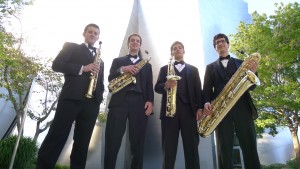Donald Sinta Quartet Commissions Recital
Website(s) : http://www.donaldsintaquartet.com
A recital of 4 pieces written for the quartet during the past two years and featuring the latest music from four up-and-coming American composers who have all written for the saxophone quartet.

Biography
The Donald Sinta Quartet are among the most successful chamber ensembles of their generation. DSQ have distinguished themselves on the competition circuit making history by being the first saxophone quartet ever to win the 1st Prize of the Concert Artists Guild International Competition. Other successes include the Grand Prize of the Coleman International Competition and 1st Prize of the NASA Saxophone Quartet Competition. They currently maintain an international performing schedule and have appeared in concert halls throughout China, Japan, France, the UK, Greece, and the US. DSQ have been featured concerto soloists with the Dallas Wind Symphony, Michigan Symphony Band, and will be featured with the Paris Garde Republicaine and Reno Philharmonic in the coming year. DSQ are Selmer Artists.
More information
One of the primary responsibilities of the modern saxophonist is to expand the repertoire through the instrument. This is a burden that we welcome and nurture as a modern saxophone quartet. Each year we hold a competition for students to send in new repertoire which we judge and then select winners from. The first two pieces on this program were winners from our 2013 contest. The first work, “Bulgarity,” by Annika Socolofsky hearkens back to her own interest in the folk music of this region and her career as a performer of folk music as well. This fast and furious piece is a kind of fusion of Bulgarian dance, violin, and saxophone playing with vulgarities normally associated with very harsh speech. The second piece, also a winner of our 2013 competition, is “Phantoms” by Natalie Moller. This work sustains a very dark mood and dramatic quality through the use of extended low and slow playing in the very lowest registers of the saxophone. This mood is shattered by a dramatic tenor saxophone solo which erupts into an intense fugue. This dramatic music dissolves into a hymn-like section before ending in very dramatic fashion in the highest register of the soprano saxophone and lowest register of the baritone saxophone. David Biedenbender has written extensively for the saxophone including his Images for saxophone and piano, Concerto for saxophone and band, and “You’ve been talking in your sleep” for saxophone quartet. The new work performed on this program is Cerulean which is a three minute exploration of the color cerulean. The first movement uses the saxophone quartet to create doppler-effect sounds mimicking police sirens. The second movement is a lullaby for Dave’s son Izaac which starts with simple repetitive patterns that gradually coalesce into a song-like melody at the close. The final movement is a fast and rhythmic depiction of a dance that his young son does, bobbing back and forth while singing a crazy, lilting tune. The final piece was written for our performance in Switzerland at CERN. The physicists there had invited us to perform for their presentation on the physics of music and composer Roger Zare wrote a one-minute tribute to their discovery of the first tetraquark – Z4430. This work features swirling technical lines along with intense explorations of the very highest register of the soprano saxophone.


 EN
EN FR
FR